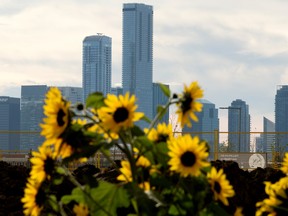David Staples: Poilievre cranks up heat for new housing but is Edmonton suddenly cooling off?
Edmonton has excelled at super charging private property owners, especially when it comes to permitting various forms of infill

Article content
Pierre Poilievre is cranking up the heat for Canadian cities to build more housing, which you would think would be good news in Edmonton. After all, it’s hard to find a city in Canada that has been more pro-growth and more pro-housing than Edmonton city council this century.
Property owners and developers have all kinds of opportunities in Edmonton that they lack in other cities, where social engineering restrictions and Not In My Back Yard attitudes have ruled the roost.
There have been more positive moves under Mayor Amarjeet Sohi to keep up the pro-housing momentum in Edmonton, but a new push by city council to restrict the development of new neighbourhoods in south Edmonton — the single most popular part of the housing market — suggests Edmonton could go in reverse. This would put it in conflict with aspiring homeowners, but also with Poilievre and his Conservatives, a party now bounding ahead of the Trudeau Liberals in federal polls.
Poilievre’s prescription for more housing has two main trusts. First, axe Trudeau’s most inflationary policies, such as his aggressive deficit spending on government, and his carbon tax.
If we go by history, sounder federal fiscal policy will help Edmonton’s housing market.
When oil prices shot up in the 1970s due to turmoil in the Middle East, Edmonton built more than 12,000 homes (apartments, row housing, semi-detached and single-detached houses combined) in 1976.
But when Pierre Trudeau’s Liberals brought in anti-Alberta oil policies in the 1980s, housing crashed here, with just 2,438 units built in 1985.
Edmonton did not build more than 10,000 units again in any one year for almost two decades, not until the federal government curbed spending, inflation and interest rates. We saw 12,581 units built here in 2002.
The Edmonton housing market kept rising until it hit a high of 17,050 homes built in 2015, the year Justin Trudeau took power and world oil prices collapsed. We saw just 10,036 homes built in 2016. That has moved up to about 11,000 new homes per year from 2017 to 2021.
Poilievre’s second policy thrust is to hammer on civic gatekeepers, essentially local city councils that have anti-housing policies. If elected, he proposes to insist high density around federally-funded transit stops and to cut federal transfers to cities that fail to increase housing permits by 15 per cent while giving more to cities that do better than 15 per cent.
There are some bugs in Poilievre’s plan, such as what happens if a worldwide economic slump causes home building permits to drop, but his overall focus on ramping up building is welcome.
When it comes to gatekeeping, Edmonton has little to worry about for now, said former city councillor Michael Walters, a partner in Berlin Communications and a key player in Edmonton’s excellent infill and suburban development regulations.
Edmonton is a decade ahead of most other Canadian cities in this regard, Walters said. Edmonton has excelled at supercharging private property owners, especially when it comes to permitting various forms of infill.
Edmonton and its civic neighbours also created a regional growth plan, Walters said, with the goal of putting the number of people moving here (about one million more in the next several decades) on a smaller parcel of land, thus making for a more efficient city and preserving agricultural land by building up the density of satellite communities and suburban neighbourhoods.
“I think we are well positioned to go forward,” Walters said. “The challenge now is not to go backward by putting constraints on what industry can do.”
One major issue is Mayor Amarjeet Sohi’s council now looking at stopping to proceed with developing new neighbourhoods in south Edmonton until other less popular new developments around the city, such as Horse Hills in the northeast, are substantially built out.
“This is a market intervention,” said Kalen Anderson, executive director of the Urban Development Institute, which represents developers in the Edmonton region. “That would be like a classic gatekeeper — to use Poilievre’s language — a bit of a gatekeeper role that the municipality is playing to directly influence the market, which would deliberately reduce supply, which would drive up costs.”
The folly of this approach is that city council can deny people new suburban neighbourhoods in south Edmonton, but that doesn’t mean they will buy infill homes in the city core or a new home in northeast Edmonton. Folks can still live south of the city in nearby Beaumont, Devon or Leduc and will likely do so.
In this way, clumsy and blunt market interventions fail. Our city councils have generally avoided such blunders in recent decades. If we want to provide affordable homes for newcomers, not to mention our own young people, it’s best to avoid them now.






Postmedia is committed to maintaining a lively but civil forum for discussion. Please keep comments relevant and respectful. Comments may take up to an hour to appear on the site. You will receive an email if there is a reply to your comment, an update to a thread you follow or if a user you follow comments. Visit our Community Guidelines for more information.